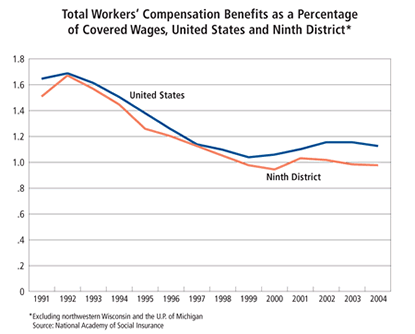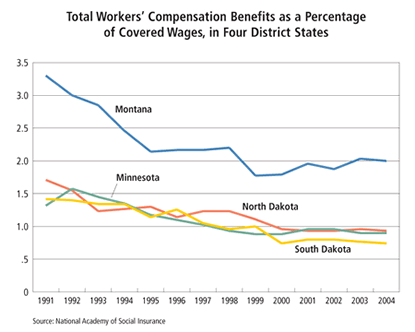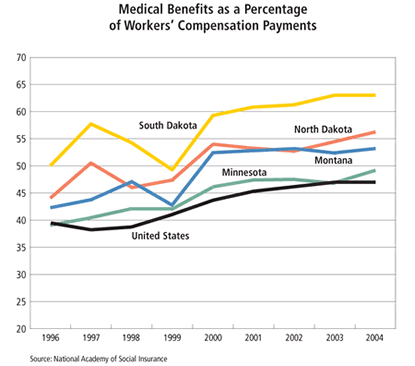Fifteen years ago the rising cost of workers' compensation programs was a perennial topic at business meetings and legislative hearings, and with good reason: Nationally, the cost of insuring workers hurt on the job had been increasing for better than a decade, doubling from about 1 percent of total payroll to more than 2 percent in 1991.
Then the ground shifted; ask businesspeople today about the factors putting stress on their balance sheets, and they'll probably point to the costs of health care and energy. "Our members saw a break in their concern about work comp costs," said Tom Hesse, vice president for government affairs at the Minnesota Chamber of Commerce.
What happened? Is workers' compensation really a lighter financial burden than it used to be? Or have other business issues pushed workers' comp into the shadows? A fedgazette analysis of workers' comp data shows that, indeed, employers have less cause to complain about workers' comp costs today than in the past. Both at the national level and in the Ninth District, benefits paid to injured workers have dropped sharply since the early 1990s. This in turn has reduced insurance premiums paid by employers.
The main drivers behind this sea change are safer workplaces and tightened state regulations that have reduced the number of fraudulent or marginal workers' comp claims.
Across the nation and in the district, total workers' comp benefits relative to payroll peaked in 1992, then fell rapidly, although the decline has been more gradual since 1997 (see chart). In Minnesota, for example, benefits paid per $100 of payroll dropped 46 percent between 1991 and 2004. Relative workers' comp payments increased slightly at the beginning of this decade, but they have retreated again in recent years.

Benefits-to-payroll ratios differ among district states (see chart). Montana employers, for example, paid almost twice the proportion of benefits as businesses in the United States as a whole in 2004, owing largely to the state's concentration of injury-prone mining and ranching industries. Minnesota, South Dakota, Michigan and Wisconsin have consistently posted slightly lower ratios than the national aggregate, while North Dakota's ratio, higher than the national level in the late 1990s, has since fallen below that mark.

However, relative payments in district states roughly parallel the national trend, which has been inexorably downward.
Safety first
Remarkably, this decline in the relative size of workers' comp payments has occurred even as societal health care costs have spiraled upward. The cost of workers' comp programs consists of two parts: the expense of treating workplace injuries, including occupational rehabilitation when necessary, and cash benefits—payments to injured employees to help them make ends meet while they're not working. Fewer workers sustain injuries today, and as a result they incur less medical expense. Since relative workers' comp costs peaked in 1991, the total number of workplace injuries nationwide has fallen 31 percent, and the rate of workplace injuries (the number of injuries per 100 workers) has fallen 43 percent, according to the U.S. Department of Labor.
Demographics are responsible for most of these safety gains. Young and elderly workers face above-average risks of being injured at work, and those groups were heavily represented in the workforce of the early 1990s, when workers' comp payments spiked. Since then many older workers have retired, and former young, accident-prone workers have matured, reducing the incidence of injuries. Meanwhile, fewer young adults are entering the workforce, resulting in a safer workforce overall.
Fewer workers' comp claims also reduces total cash benefits, because fewer injured or disabled employees miss work and become eligible for cash assistance. Less money paid out to convalescing workers explains why the medical component of workers' comp benefits has grown as a percentage of total benefits.
"If you went back 25 years ago, probably a third of the benefit payments were medical and two-thirds were cash benefits," said John Burton, a professor of management and labor relations at Rutgers University who researches workers' compensation issues.
At the national level, medical care's share increased from less than 40 percent in 1996 (the earliest year for which state-level data are available) to almost 47 percent in 2004. The increase in some district states has been even more dramatic: In North Dakota the medical portion of workers' comp payments surged from about 44 percent to 56 percent over the same period (see chart).

Thus, as medical costs have taken a bigger bite out of the total workers' comp pie, that pie has shrunk, reducing the benefits per dollar of payroll paid by employers.
Clamping down
Regulatory changes have also lightened employers' workers' comp burden, primarily by tightening eligibility requirements for cash benefits.
Since it was created in the early 20th century, workers' compensation has been administered by the states, which are responsible for setting eligibility rules and other regulations. Between 1989 and 1996, partly in response to lobbying by employers, about half of all states nationwide changed their workers' comp laws.
In the district, South Dakota is a good example. A 1994 law clamped down on cash benefits, requiring solid proof that an injury was job related and serious enough to require time off from work. Since then, workers' comp payments relative to payroll in South Dakota have fallen significantly, dropping 28 percent by 2004—more than twice the decrease in the district aggregate of about 11 percent. Because getting paid time off from work has become more difficult, the medical share of total benefits has also risen sharply in the state, from 50 percent in 1996 to about 63 percent in 2004.
Minnesota and North Dakota also overhauled their workers' comp regulations in the mid-1990s, raising the bar for workers applying for disability payments or cash benefits.
Research in the early 1990s by Richard Butler, an economist now at Brigham Young University, indicated that the national run-up in workers' comp costs at that time was due to imperfectly monitored workers exaggerating the severity of injuries. Butler theorized that lucrative benefits and relatively short claims processing times in the early '90s induced workers to file more claims of greater severity. So the number and dollar value of claims increased even as workplaces became safer.
Tougher state regulations enacted to address employers' concerns about rising costs apparently threw that mechanism into reverse by discouraging some workers from filing workers' comp claims. A reduction in both medical and cash-benefit payments followed.
Now, about those escalating health care and energy costs...
Joe Mahon is a Minneapolis Fed regional outreach director. Joe’s primary responsibilities involve tracking several sectors of the Ninth District economy, including agriculture, manufacturing, energy, and mining.





